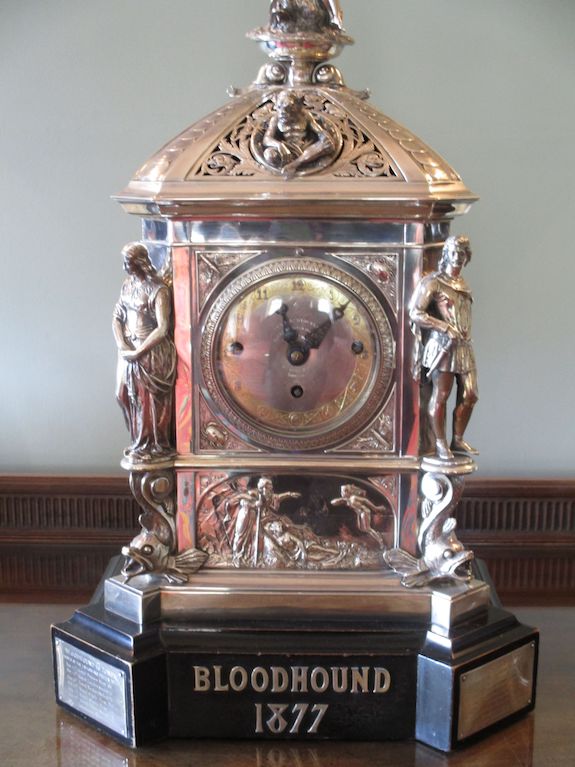
One of the most successful ocean racing yachts ever built – the Bloodhound – was also the vessel on which Prince Charles and Princess Ann learned to sail. It was based on a boat built in 1874 for the Scottish Marquess of Ailsa. The sailing yacht (also named the Bloodhound), won every race in which it was entered, and it earned the Marquess a considerable amount of money. When it won £2,000 in 1877 alone (in today’s dollars, about $2,616, a huge sum at the time), the Marquess commissioned the making of a clock to commemorate the win.
 One of the best silversmiths of the day, Alexander Crichton, crafted the highly detailed exterior of the clock now on display at Culzean Castle. He had made his mark with his first known major work in 1878 with a pair of parcel gilt shields based on Shakespeare’s “A Midsummer Night’s Dream.” The Shakespearean theme would show up again in the clock he made for the Marquess, and though there isn’t one dog in the design, the famous clock is known as the Bloodhound Clock.
One of the best silversmiths of the day, Alexander Crichton, crafted the highly detailed exterior of the clock now on display at Culzean Castle. He had made his mark with his first known major work in 1878 with a pair of parcel gilt shields based on Shakespeare’s “A Midsummer Night’s Dream.” The Shakespearean theme would show up again in the clock he made for the Marquess, and though there isn’t one dog in the design, the famous clock is known as the Bloodhound Clock.
If it’s curious that a clock named the Bloodhound doesn’t include a dog on the design, consider how odd it is that a speed vehicle is named for a breed not known for speed. The Bloodhound LSR is a British land vehicle designed to travel at supersonic speeds with the goal of setting a land speed record. The arrow-shaped car powered by a jet engine and will be fitted with an additional rocket engine, but it sounds as if the project was stalled during the pandemic. The most recent update that came in August, 2021 reported that the car was moved temporarily to the Coventry Transport Museum, but that fundraising for the final record breaking phase was ongoing.
What is the record the car is hoped to set?
The current world land speed record of 763.035 mph was set over 20 years ago by a British team that included the Bloodhound LSR driver, Andy Green. Because of advances in engineering design, materials and computational fluid dynamics in the last two decades, confidence is high that the record will be broken, and perhaps by a lot. Though it is part of human nature to push the envelope by going higher, deeper or faster, projects like putting a man on the moon – and yes, breaking a land speed record – inspire engineers to think outside the box. As a result, new inventions and technologies are developed. Consider what we got out of the Apollo moon program: The Dustbuster, thermal blankets, pens that write upside-down, fireproof garments for firefighters, vacuum-sealed food, shock-absorbing soles for athletic shoes, ear thermometers, the Jaws of Life, wireless headsets, memory foam, freeze dried food, LEDs, computer mice, and so much more.
Pushing boundaries requires new technologies, and engineers and manufacturers are challenged to think in new ways. Who knows will come out of a wicked fast Bloodhound?
Image: Running Bloodhound by ©Camillekphotographyak/Dreamstime
